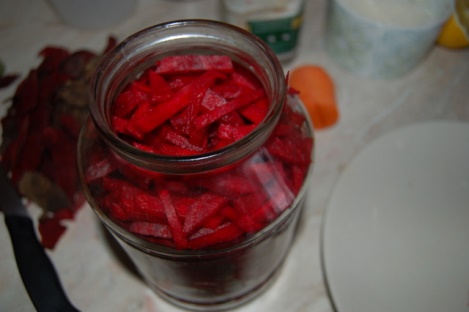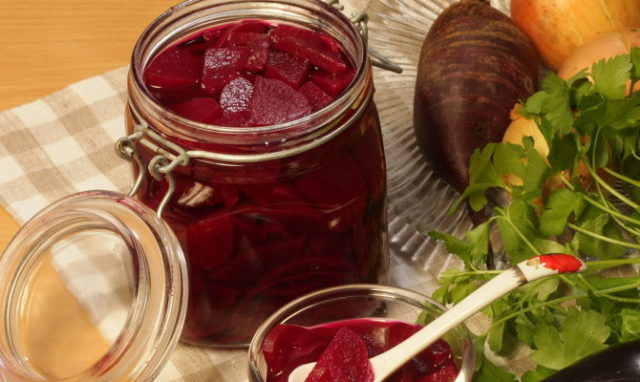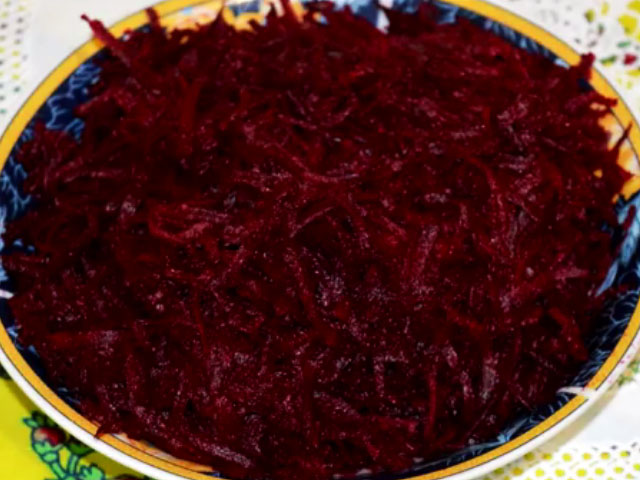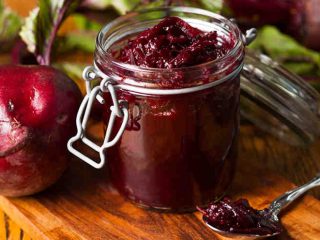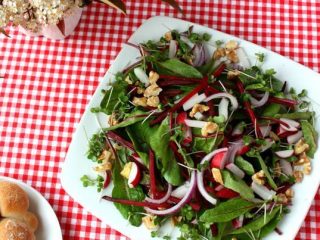Content
- 1 Sauerkraut: benefits and harms
- 2 How to ferment beets at home
- 3 The classic recipe for sauerkraut for the winter
- 4 The easiest sauerkraut recipe
- 5 How to ferment beets for borscht at home
- 6 Recipe for pickling beets in Georgian
- 7 How to make sauerkraut with carrots
- 8 Beets pickled in jars with garlic and spices
- 9 Instant pickled beets
- 10 Sauerkraut: hot pepper recipe
- 11 Sauerkraut without salt: with caraway seeds and rye bread
- 12 Recipe for pickled beets with horseradish
- 13 Pickled beet leaves
- 14 Storage rules for sauerkraut
- 15 Conclusion
Everyone knows that there is sauerkraut, and this is a delicious preparation for any table. But few have tried sauerkraut, which tastes just as good as the classic cabbage recipe. Pickled beets for the winter can replace many snacks on the festive table, and dinner with such a dressing turns out to be delicious.
Sauerkraut: benefits and harms
Sauerkraut has all the beneficial properties of a raw root vegetable. It is useful for hypertension as it lowers blood pressure. Sauerkraut is useful for the enzymes that are formed, which help to normalize digestion. A vegetable can show its negative qualities only with excessive manifestation. If you drink a lot of brine or get carried away with the use of sauerkraut, it threatens bloating and flatulence. Fermented preparations should not be consumed with increased acidity of the stomach.
After fermentation, the maximum amount of nutrients is preserved, including:
- citric and malic acids;
- vitamins of group B, C, as well as E and beta-carotene;
The root vegetable fights disease, strengthens the immune system, and also resists scurvy. In addition, the root vegetable has a low calorie content, which is very useful for those who follow a diet;
But you can not get carried away with root crops in chronic pancreatitis, cholecystitis, as well as duodenal ulcer.
How to ferment beets at home
In order to get an original and delicious recipe for sauerkraut, first of all, you need to select and prepare the ingredients. It is better to take a root crop of a small variety and a bright burgundy color. So it will retain its color and give the desired shade to winter dishes, including borscht. To add a spicy aroma or pungent taste, the hostess selects ingredients to her taste, as well as combinations of seasonings. If you want to get a sharper dish, then you should additionally add hot pepper, garlic.
If you have to ferment a root vegetable for the first time, you should choose a simple recipe with a small amount of ingredients.
If the recipe contains salt, use standard table salt and never use iodized salt. This salt will give the workpiece a bitter and unpleasant aftertaste.
The classic recipe for sauerkraut for the winter
For the classic recipe, you only need 1 kg of beets, as well as a liter of water and salt to taste. This is the minimum set of products that you need for the simplest recipe for sauerkraut for the winter. This will give the preparation a standard taste and pleasant aroma, and borscht and other winter dishes will have a pleasant burgundy color.
The cooking algorithm is not difficult:
- Cut the root vegetable.
- Make brine from water and salt.
- Pour brine over the beets.
- Put heavy oppression on top.
- Withstand 2 weeks, constantly removing foam and formed mold.
After two weeks, it is possible to put the jar in a cellar or other cool place to store the workpiece.
The easiest sauerkraut recipe
The following ingredients are required in a standard fermentation recipe:
- root vegetable - 1 kg;
- salt - 2 tbsp. spoons;
- 700 ml of water.
The cooking process is also simple:
- Peel and cut the root vegetable into cubes. You can grate on a coarse grater. The less the product is prepared and processed, the less time it takes to prepare and marinate it.
- Transfer to banks.
- Pour water into a saucepan and add salt, bring to a boil.
- Pour the beets and seal the containers; a nylon or screw cap is quite suitable for this.
- After 10 days, you can take the first sample.
This is a classic, most simple recipe that will allow even inexperienced housewives to make a fermented product. The minimum set of products is perfectly acceptable and will not make cooking too expensive.
How to ferment beets for borscht at home
Homemade pickled beets will give the borsch an unforgettable taste and pleasant appearance. The ingredients for preparing such a dish are minimal and simple and every housewife has:
- 1-2 small roots, preferably oblong;
- a third of a teaspoon of salt;
- 2 cloves of garlic;
- black peppercorns;
- water;
- Bay leaf.
Preparing a recipe is also not difficult:
- Wash, peel and dry the beets.
- Cut into thin and small slices. The smaller and thinner the beets are cut, the less time they will ferment.
- Put all the spices on the bottom of the fermentation container.
- Place the beets tightly on top.
- A third of a teaspoon of salt should be diluted in 100 ml of water.
- Pour over the beets and add water so that it covers the root vegetable.
- Place in a warm place, do not cover with a lid.
- After a couple of days, foam will appear, it needs to be removed.
- Everything will be ready in 10-14 days.
It is better to store such a workpiece in a cool place, for example, in a cellar.
Recipe for pickling beets in Georgian
For a starter culture according to the Georgian recipe, you need a little more products. This beetroot, pickled for the winter according to the recipe, is very tasty and unusual. Many housewives cook it with great pleasure:
- a kilogram of root vegetables;
- 150 g celery and parsley roots;
- 100 g of dill;
- 20 g garlic;
- a large spoonful of salt;
- chilli pepper;
- bay leaf.
Step-by-step cooking algorithm:
- The vegetable should be thoroughly washed and cooked.
- After 10 minutes, cool directly in the broth and peel the root vegetable.
- Using a beautiful embossed knife, cut the beets into slices.
- Boil 2 cups of water, add salt, celery, parsley, garlic and simmer for 2 minutes.
- Cool vegetables and broth separately.
- Place the cooled and chopped vegetable in a container, add bay leaf and paprika.
- Pour everything with cooled broth.
- In order for the brine to completely cover the beets, add boiled water.
- You can use the sauerkraut in a few days.
This is a delicious and quirky recipe that is easy to prepare.
How to make sauerkraut with carrots
There is a recipe for making a pickled root vegetable with the addition of carrots. It is both tasty and healthy. Ingredients for the recipe:
- 2 kg of root crops;
- a pound of onions;
- table salt - 50 g.
Step-by-step fermentation instructions:
- Wash, clean and chop vegetables.
- Add salt to the container and stir.
- Leave everything under oppression for 12 hours.
- Drain the juice that will stand out.
- Separately in a saucepan, boil the brine from 50 grams of salt and a liter of water.
- Pour vegetables with hot brine, put oppression on top, put in a cool place.
After a few days, the finished fermented dish can be tasted and added to various culinary masterpieces.
Beets pickled in jars with garlic and spices
To prepare a recipe with spices, you need the following set of products:
- a kilogram of root vegetables;
- a spoonful of salt;
- head of garlic;
- 600 ml of water;
- 1 PC. hot pepper;
- dill seeds - spoon;
- a teaspoon of peppercorns and allspice;
- dill greens.
Step-by-step cooking recipe:
- Wash the root vegetable and place in cold water.
- Boil for an hour.
- Cut into wedges.
- Pour all the necessary spices into a sterilized prepared jar.
- Put the garlic, chopped into slices, pepper pod.
- Arrange the chopped beets alternately with dill seeds and garlic cloves.
- Add table salt and the remaining spices to the water.
- Simmer for 5 minutes.
- Cool down.
- Pour the prepared brine over the beets in the jars.
- Cover and refrigerate.
The result is a fast and high-quality product with a unique taste and unforgettable aroma.
Instant pickled beets
A minimum of ingredients is required for quick cooking. This recipe takes no time or effort:
- a pound of beets;
- a tablespoon of salt.
Recipe:
- Dissolve a spoonful of salt in a glass of water.
- Put chopped beets in a jar and also mix them with salt.
- Put it under oppression so that the root vegetable lets out the juice.
- Pour the brine into the jar almost to the very top.
- Cover with a lid, shake and place in a warm place.
After a couple of days, the product is ready for use.
Sauerkraut: hot pepper recipe
This is another original recipe for making sauerkraut. In this version, it is pre-boiled. Products for fermentation for the winter at home will need the following:
- 2 kg of beets;
- a teaspoon of peppercorns;
- head of garlic;
- pod of red hot pepper;
- Bay leaf;
- vinegar;
- greens.
Step-by-step cooking recipe:
- Boil the beets until tender.
- Cool and cut into wedges.
- Prepare a brine from water, salt, parsley, celery and add a spoonful of vinegar.
- Boil for 5 minutes, then refrigerate.
- Put beets and all spices in a jar, including hot peppers.
- Tamp tightly.
- Pour with brine.
- Place in a warm place for 3 days.
After three days, the spicy boiled beets are ready. Can be served at the table.
Sauerkraut without salt: with caraway seeds and rye bread
This is an old recipe that has been known since ancient times. Our ancestors used it, and now many modern housewives cook with pleasure. Products will be needed:
- root vegetable 4 kg,
- cumin 80 g,
- rye bread 400 g.
It is recommended to cook beets as follows:
Cut the beets into slices and add to the cooking container. Sprinkle with caraway seeds and leave in cold water.
Soak the bread in warm water and pour the brine over the jar to the very edges. Put oppression in a jar, leave in a warm place for fermentation. After a few days, you can use the beets for consumption.
Recipe for pickled beets with horseradish
A spicy recipe for which you need to prepare everything you need in advance so that it does not corrode your eyes. The ingredients are:
- 150 g horseradish root;
- root vegetable - 1 piece;
- 2 tablespoons of sugar;
- a small spoonful of sugar;
- 6 tablespoons of 5% vinegar.
The cooking algorithm is also simple:
- First of all, the horseradish root should be chopped.
- Chop the root vegetable and add its juice to the horseradish.
- You can also add the pulp of the vegetable to the horseradish to make the seasoning less hot.
- Add salt, granulated sugar and vinegar. Mix everything and arrange in clean, sterilized jars.
- The best option is to prepare everything in advance so as not to come into close contact with horseradish.
The downside of this snack is that it is not stored for long, because it quickly loses its strength. Therefore, experienced housewives harvest it in small portions.
Pickled beet leaves
The most experienced housewives use not only root crops directly for fermentation, but also beet leaves with petioles. For starter culture at home, not only beets can be used, but also useful greens. Ingredients for this recipe:
- a kilogram of beet stalks;
- a tablespoon for 1 jar of blank;
- head of garlic;
- Bay leaf;
- black peppercorns.
Cooking steps:
- Cut the garlic into thin slices.
- Wash the leaves and cut into small pieces up to 5-7 cm.
- To make the leaves soft, pour boiling water over the leaves, and then immediately drain the water so as not to soften the beet tops too much.
- Put pepper, tops, garlic, bay leaf in layers in prepared jars.
- Pour salt on top.
Pour boiling water over and leave for a couple of days in a warm place. If there is a desire for the process to drag on for a long time, then it is better to clean it in a cool place.
Storage rules for sauerkraut
Pickled beets for the winter are stored according to the general rules for such preparations. While the product is fermenting, it should be stored in a warm place or at room temperature. This makes the fermentation process more active. After the product has fermented, you can safely put it in a cool room for winter and storage. This can be a cellar, a basement, and in an apartment a pantry or a balcony is a suitable place if the temperature there does not drop below zero degrees.
Conclusion
Sauerkraut is of great benefit for the winter, it helps to improve blood circulation, normalize the digestive tract, and also has a positive effect on cholesterol levels. Resists anemia and improves blood counts.

